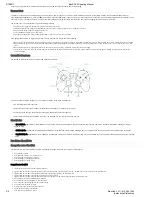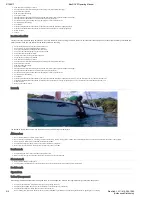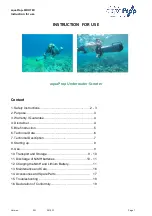
2/10/2017
BlueROV2 Operating Manual
3/5
Push and twist the battery enclosure.
Visually check that all screws holding the back end caps are installed and look tight.
Pull on all of the thrusters.
Grab and shake the fairings.
Pull on the
Lumens
.
Visually check that all screws holding the dome and front battery end cap are installed and look tight.
Visually check the radial seals on the electronics and battery enclosure.
Put the ROV on the ground and make sure that people are clear of the thrusters.
Put the ROV in manual mode.
Arm the ROV.
Press the forward/reverse stick forward to check that the vectored thrusters are spinning freely.
Press the ascend/descend stick forward to check that the vertical thrusters are spinning freely.
Disarm the ROV.
Launch.
Pre-Dive Checklist
This checklist should be done every time the ROV is put into the water, prior to putting the ROV in the water. This checklist starts after you have connected the battery, reinstalled the
battery enclosure end cap, and reinstalled the battery enclosure vent plug.
Check that the ROV has connected to QGroundControl.
Gently attempt to twist the ballast weights clockwise.
Pull on the side panels and attempt to twist the frame.
Pull on the cable bundles going into the 14 hole end cap.
Pull on and twist the tether thimble.
Attempt to loosen all of the penetrators by hand.
Check that the vent plugs are installed.
Push and twist the battery enclosure.
Visually check that all screws holding the back end caps are installed and look tight.
Pull on all of the thrusters.
Grab and shake the fairings.
Pull on the
Lumens
.
Visually check that all screws holding the dome and front battery end cap are installed and look tight.
Visually check the radial seals on the electronics and battery enclosure.
Put the ROV on the ground and make sure that people are clear of the thrusters.
Put the ROV in manual mode.
Arm the ROV.
Press the forward/reverse stick forward to check that the vectored thrusters are spinning freely. Do not run the thrusters for more than 30 seconds in air.
Press the ascend/descend stick forward to check that the vertical thrusters are spinning freely. Do not run the thrusters for more than 30 seconds in air.
Disarm the ROV
Now you are ready to launch
Launch
The
BlueROV2 can be launched in many conditions. Some conditions require special care.
All Launches
Do not launch the ROV near swimmers or divers.
Do not release the ROV prior to it touching the water. If necessary, use the tether to lower it down. When lowereing the ROV, keep the dome away from any hard or sharp objects.
Do not launch in water that is too shallow to freely drive the ROV.
Keep the ROV away from boats that do not know that the ROV is in the water.
Do not arm until the ROV is in the water and the launcher is clear of the ROV.
Boat Launch
Keep the ROV and tether clear of the boat’s propellers or jets.
Make sure that the captain of the boat knows that the ROV is about to be launched.
Shore Launch
Do not launch the ROV in heavy surf.
You may need to walk the ROV into the water to get to a point where the water is deep enough to drive the ROV.
Dock Launch
Operation
Tether Management
When diving the
BlueROV2 the tether will require some active management. Here are some guidelines for good tether management:
Keep the tether away from propellers or jets if you are operating on a boat.
Keep the tether and ROV away from other boats that are not aware that it is in the water.
Keep the tether away from sharp objects such as coral, rocks, etc.
Do not deploy too much tether. Excess tether in the water will add drag to the ROV and opportunity for the tether to get caught on something.
BlueLink, LLC / 619-204-1060
(Authorized Distributor)






